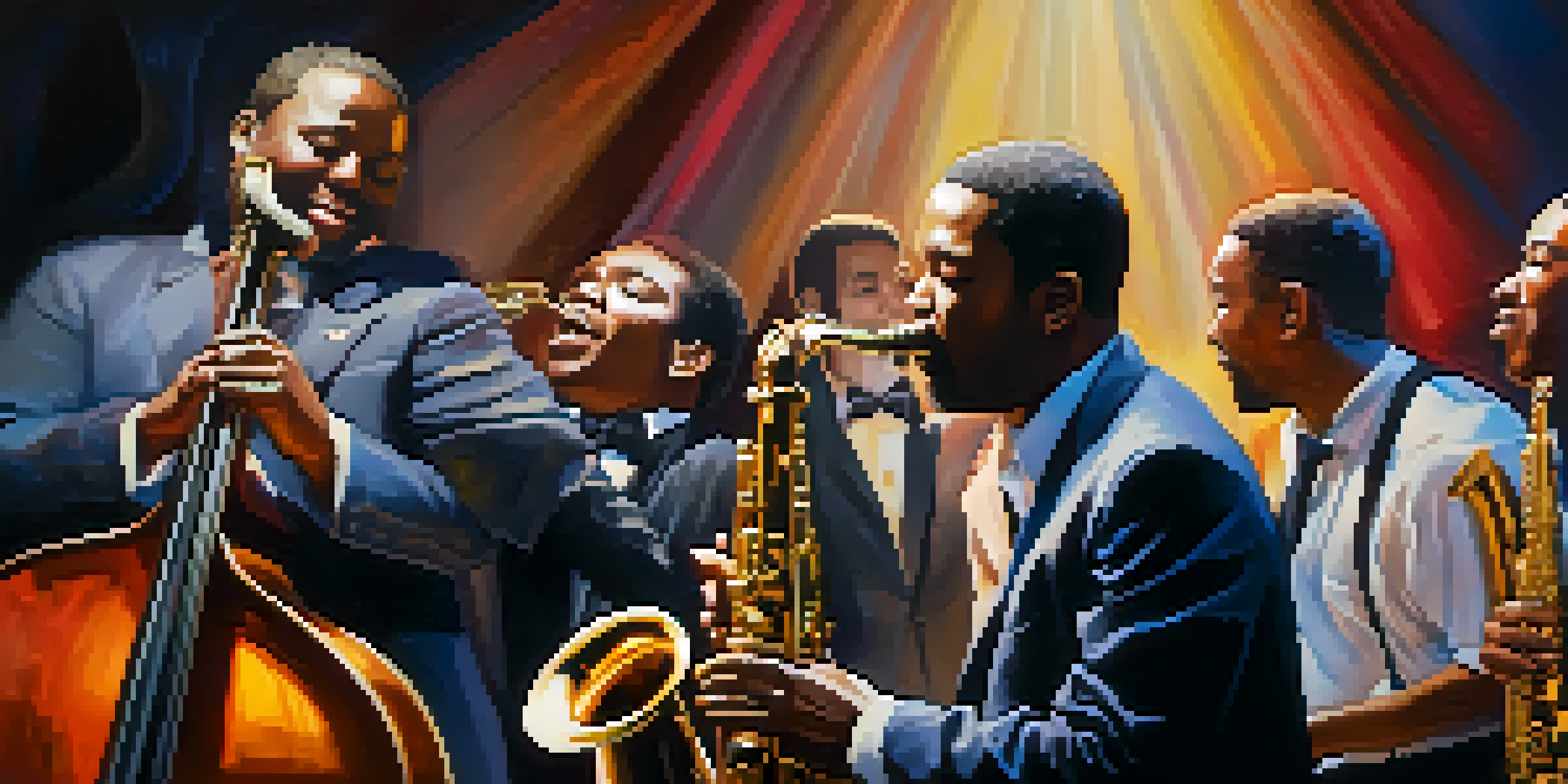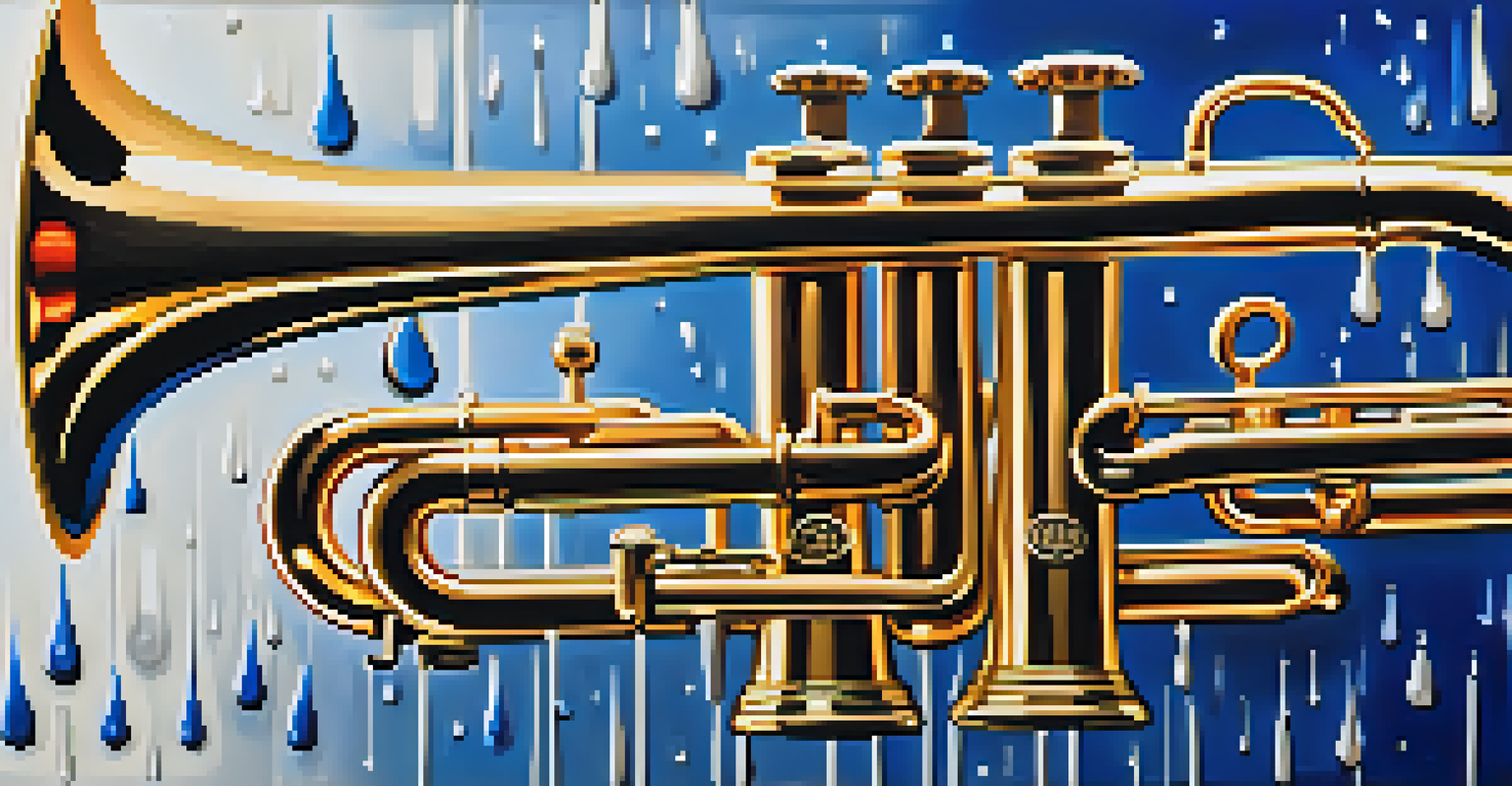Analyzing Jazz: The Unique Structure and Elements of the Genre

Understanding the Essence of Jazz Music
Jazz is more than just a genre; it's a vibrant expression of culture and emotion. Originating in the early 20th century, it combines African American musical traditions with European influences. This fusion creates a distinctive sound that resonates with many, making jazz a beloved art form worldwide.
Jazz is the only music in which the same note can be played night after night but differently each time.
At its core, jazz embodies improvisation, where musicians spontaneously create melodies and harmonies. This element of surprise keeps both the performers and the audience engaged, as no two performances are ever the same. It reflects the freedom and individuality that jazz musicians cherish, allowing them to showcase their unique voices.
Furthermore, jazz is deeply rooted in the concept of collaboration. Musicians often play off each other's ideas, creating a dynamic interplay that showcases their collective creativity. This sense of community is integral to jazz, making it not just a solo endeavor but a shared experience.
Key Elements: Rhythm and Time in Jazz
Rhythm is a foundational element of jazz, characterized by syncopation and swing. Unlike many other genres that rely on strict beats, jazz allows for a more fluid approach to rhythm, adding a sense of playfulness. This unpredictability invites listeners to tap their feet and move along with the music.

The concept of 'swing' is particularly important in jazz, where the emphasis shifts from the downbeat to the upbeat. This creates a laid-back feel, making the music feel alive and dynamic. It’s almost as if the music is dancing, encouraging both musicians and audiences to let loose and enjoy the moment.
Jazz is a Cultural Expression
Originating from African American traditions, jazz serves as a vibrant expression of culture and emotion.
Moreover, jazz rhythms often borrow from various cultural influences, making it a melting pot of styles. From African rhythms to Latin beats, the diversity in jazz rhythm contributes to its rich tapestry. This openness to different influences is what keeps jazz evolving and relevant across generations.
Melody and Harmony: Crafting Jazz's Unique Sound
Melody in jazz is often characterized by its improvisational nature, allowing musicians to explore and experiment. Unlike traditional melodies that may follow a set path, jazz melodies can twist and turn, reflecting the musician's emotional journey. This freedom gives each performance its own identity.
The great thing about jazz is that there’s a lot of freedom. You can do whatever you want and express yourself in any way.
Harmony plays a crucial role as well, often employing complex chords that create a rich sonic landscape. Jazz musicians frequently use extended chords, which add depth and texture to their music. This complexity challenges listeners to appreciate the intricate layers within each piece.
Additionally, jazz harmonies often involve the use of 'chord changes,' where musicians shift from one chord to another in unexpected ways. This keeps the music fresh and exciting, encouraging musicians to take risks and push boundaries. It's this adventurous spirit that keeps jazz alive and thriving.
The Role of Improvisation in Jazz Performance
Improvisation is at the heart of jazz, allowing musicians to express their creativity in real-time. It’s like a conversation where musicians communicate through their instruments, responding to each other's ideas on the spot. This spontaneity is what makes each performance unique and memorable.
Jazz improvisation can be likened to storytelling; musicians weave narratives through their solos. They may start with a theme, then explore variations, creating an emotional arc that captivates the audience. This ability to connect through improvisation is what sets jazz apart from more structured genres.
Improvisation is Key to Jazz
Improvisation allows musicians to create spontaneous melodies and harmonies, making each performance unique.
Moreover, improvisation encourages a deep level of listening and interaction among musicians. They must pay close attention to each other, adapting their playing in response to the group's dynamics. This collaborative aspect fosters a sense of unity, transforming a solo performance into a collective experience.
Jazz Forms: Exploring Different Structures
Jazz encompasses various forms, each with its own structure and style. Some of the most popular forms include the blues, which features a 12-bar structure, and the standard song form, often labeled as AABA. These forms provide a framework within which musicians can improvise and create.
Another notable form is the jazz ballad, characterized by slower tempos and emotive melodies. Ballads allow for introspection and deep expression, showcasing the musician's ability to convey feelings through music. This emotional depth is a hallmark of jazz and resonates powerfully with listeners.
Additionally, modern jazz often blends traditional forms with contemporary styles, resulting in innovative sounds. Musicians experiment with fusion genres, incorporating elements from rock, funk, and hip-hop. This evolution of forms ensures that jazz remains a dynamic and exciting genre for both artists and fans.
Influential Jazz Musicians and Their Impact
Throughout its history, jazz has been shaped by countless influential musicians who have left their mark on the genre. Icons like Louis Armstrong and Duke Ellington not only defined the sound of early jazz but also influenced future generations of musicians. Their innovative approaches to melody, rhythm, and improvisation continue to inspire artists today.
In the mid-20th century, figures like Miles Davis and John Coltrane pushed the boundaries of jazz even further. They experimented with modal jazz and free jazz, encouraging musicians to explore new territories. Their fearlessness in breaking conventions opened doors for a multitude of styles within the genre.
Jazz Influences Global Music
Jazz has transcended borders, impacting music worldwide and inspiring countless musicians across various genres.
Moreover, contemporary artists such as Kamasi Washington and Esperanza Spalding are keeping the jazz tradition alive while infusing it with modern influences. They reflect the genre's adaptability and relevance in today's music scene. By blending jazz with elements of pop, soul, and R&B, they attract a new generation of listeners.
The Cultural Significance of Jazz Music
Jazz is not just a musical style; it's a cultural movement that has played a vital role in American history. Emerging from the African American community, jazz has been a powerful form of expression, highlighting social issues and personal stories. It became a voice for those who sought freedom and equality.
Moreover, jazz has transcended borders, influencing music worldwide. From the streets of New Orleans to the clubs of Paris, jazz has inspired countless musicians and genres. Its global reach speaks to the universal emotions that jazz can evoke, making it a truly international phenomenon.

Today, jazz continues to be a symbol of creativity and resilience. Festivals and events dedicated to jazz celebrate its rich history while showcasing new talent. This ongoing appreciation ensures that jazz remains relevant, bridging generations and cultures through the power of music.